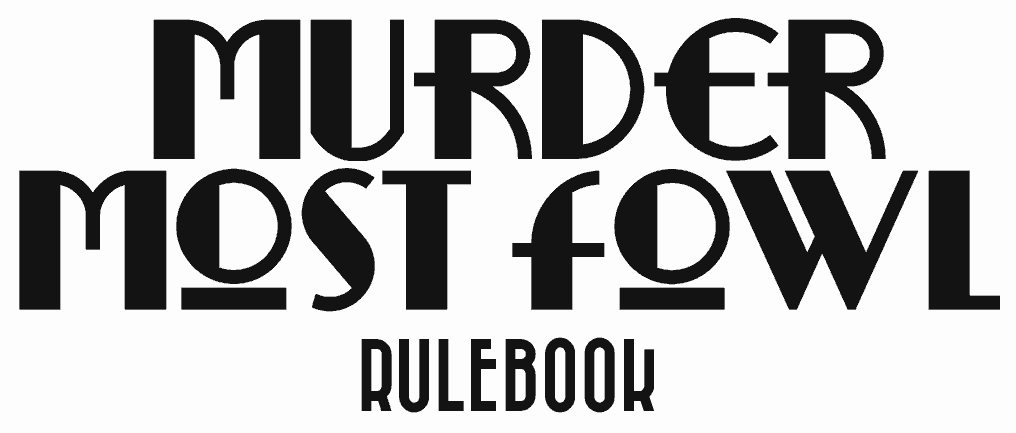
This is v1.1 of the Murder Most Fowl rulebook. If your copy of the game came in a cardboard tuck box, this is the version you need. If your copy came in a plastic box, please see v1.0 instead.
Introduction
Murder Most Fowl is a game for two to four players, inspired by Agatha Christie stories of small-stakes activities being treated very seriously. You and your friends can play it as a simple pattern-matching, path-building game, giggling at the silly names of made-up birds. But you can start messing with them, you can push their limits, you can ramp things up… and if things are pushed too far, maybe one of you will be driven, in the pursuit of birding success…
…to murder
Access
Murder Most Fowl is a game of building paths and reaching a communal deck of cards. It relies on open information, and players being able to interpret one another’s cards.
And always: Remember to respect the players and their needs.
Components
In your copy of Murder Most Fowl, you should have the following:
- A Deck of 70 Cards
- 60 Bird cards:
- 10 Birbles, numbered 1-10
- 10 Grushes, numbered 1-10
- 10 Piptits, numbered 1-10
- 10 Runceys, numbered 1-10
- 10 Thrums, numbered 1-10
- 10 Wardlurs, numbered 1-10
- 10 Wile cards
- 4 Blocking Wiles, numbered 1
- 3 Discard Wiles, numbered 2
- 2 Swap Wiles, numbered 3
- 1 Murder Wile, numbered 4
- 60 Bird cards:
How To Play
Play starts with the player who can name the most ridiculous Agatha Christie novel conclusion, or really, with whoever you select, at random, it doesn’t matter, it’s fine.
Setup
First, make sure the deck is the right size for your players. The number of bird types you have in the deck depends on how many players you have. The more players you have, the more bird types you need available. It doesn’t matter which types you include, so pick the ones you think have the funniest names to keep. The fewer players, the fewer types of birds, like so:
| Players | 2 | 3 | 4 |
| Bird Types | 4 | 5 | 6 |
Then, when the deck is the right size, shuffle it up and set it in the middle of the players.
For each player, take the top card off the deck and set it next to the deck face-up as a discard pile, closest to that player. That’s that player’s discard.
Then, each player draws two cards. Each player should only ever have two cards in hand at the end of their turn.
Turns
In Murder Most Fowl, each turn is the same: Each player Draws two cards, Discards a card, then Plays a card.
When you Draw a card, you can take a card from either the top of the deck, or a card from any of the discard piles. You have to take at least one card from the top of the deck each turn.
When you Discard a card, you put it from your hand into your discard pile.
When you Play a card you put the card on the table in front of you, directly next to one of your existing cards to the left, right, or above or below it.
Cards have to be placed adjacent to one another, horizontally or vertically, but the order you place them isn’t necessarily the route you score.
If you have a 6 and a 2 early on, but don’t see any 4s or 3s floating around, you could place them so you can loop back around with a 4 and a 3.
Your opponents may also want to interfere with your path by placing blocks in it, or making you discard cards from it. This means you’ll always want to plan for the shape your path can take, and be prepared to change your plans.
Goal
What you’re trying to do is construct, amongst your notes of the birds you’ve seen, a route showing the judges a most excellent parade of birds such as only a talented birder would show.
When you’ve laid out all your cards in front of you, you want to find a route through the path that starts with a low numbered card, and ends on a higher numbered card. At the end of the game, you count how many cards you can map in this route, from the lowest number to the highest of the same Type of bird.
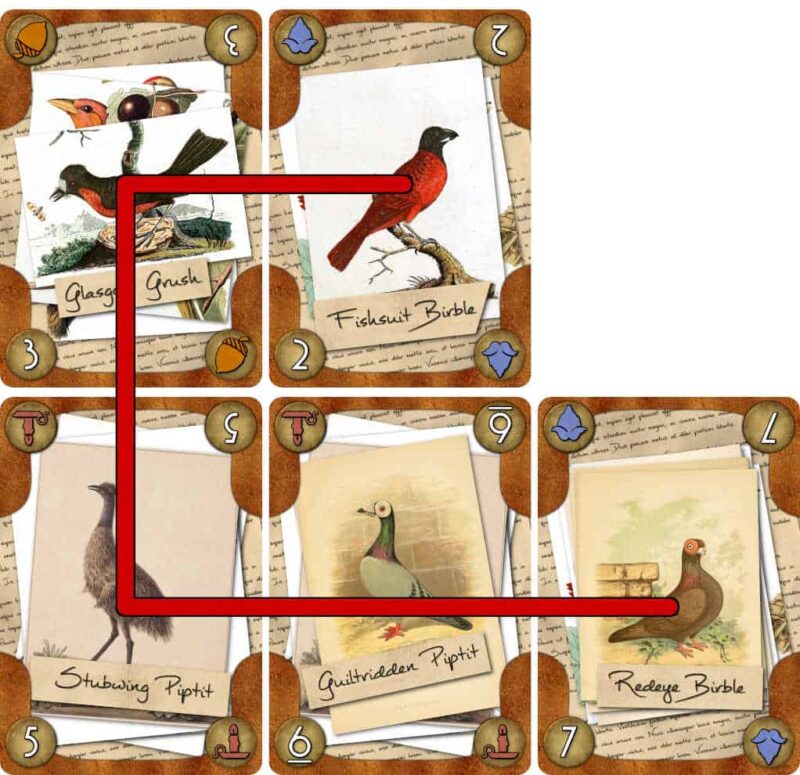
Provided your route is 4 or more cards, you score one point for each card. However, if more than half your birds are the same type, you score double points.
You’re only tested at the end of the game for the best path you can make… or at the moment of murder.
Scoring
First, you need to draw a line in your path to show your route. This route:
- Starts and ends with a bird of the same type
- Must be at least four cards long
- Always increases in value; 1-2-3 is fine, as is 1-3-5. You can skip numbers, so long as you move to a higher numbered bird.
- If more than half of the path is the same type of bird, it is worth double
Then, the living player with the highest score is the winner!
Wiles
Wiles are skull-marked cards that cause trouble for your opponents. A Wile card in your Route has no value for calculating points and doesn’t impress the judges at all. They’re things that disrupt your path in some way. Wile cards do have numbers on them – these are their escalation value.
There is one Wile that requires a little explanation: Murder.
Murder
First of all, you might ask, as any reasonable Birder would, when is it justified to Murder someone? Well, you can play the Murder card just like any other card, on your turn, but the trick is getting away with it.
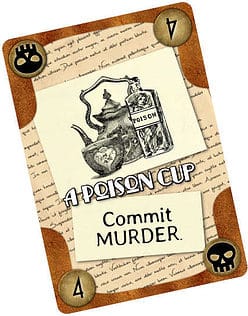
You can murder someone if you think their route is 4 points better than yours, or if all the wiles played have escalated. Note that it’s possible to be mistaken about someone’s route: Check and be careful before you attempt a murder, because if you are wrong, you are caught in the act! Your Murder fails and you are apprehended by stout bobbies who cart you off to face justice.
Alternatively, you can murder after there has been Escalation. Escalation is when there are wiles of all the other values – 1, 2, and 3 – in play, in any number of players’ paths. In that case, the time is ripe for murder.
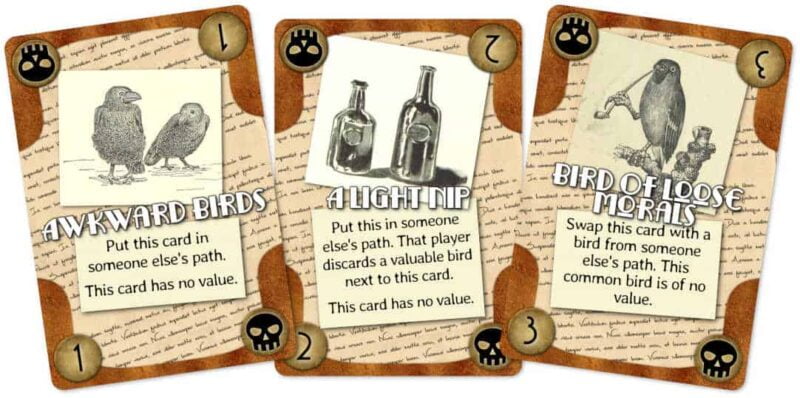
And what for the victim of this murder most fowl? Well, they stop playing the game. They don’t draw more cards or play more cards or any such nonsense. If this means there’s only one player left, that player stops building their own path, and time comes to score the route through it.
But! You’re not safe yet!
The victim does have the opportunity to ruin your plans. If your route starts and ends with a type of bird they have in their hand when they were murdered, the police see that as just cause to arrest you. The murder victim may not be able to win – but you have lost respect before the eyes of the Birder society. And isn’t that so much worse?
Last Words
And that’s that! That’s how to play Murder Most Fowl. You can try and craft a little puzzle out of the bird cards that come into your hand, or you can get vicious and start messing with your friends’ paths.
Have fun!
Credits
Game, Rulebook: Talen Lee
Art: The art for this game come from Public Domain naturalism paintings from the late 1800s.
Creative Commons Resources: Carl Olsen, Delapouite, John Redman, Lorc, Lord Berandas, Priorblue, Sbed, Viscious Speed & Willdabeast, via www.game-icons.net
Special Thanks
- To my mum, with whom I watched a bunch of Poirot
- To Æryn, for talking game design
- To Fox and Elli, for walks and talks

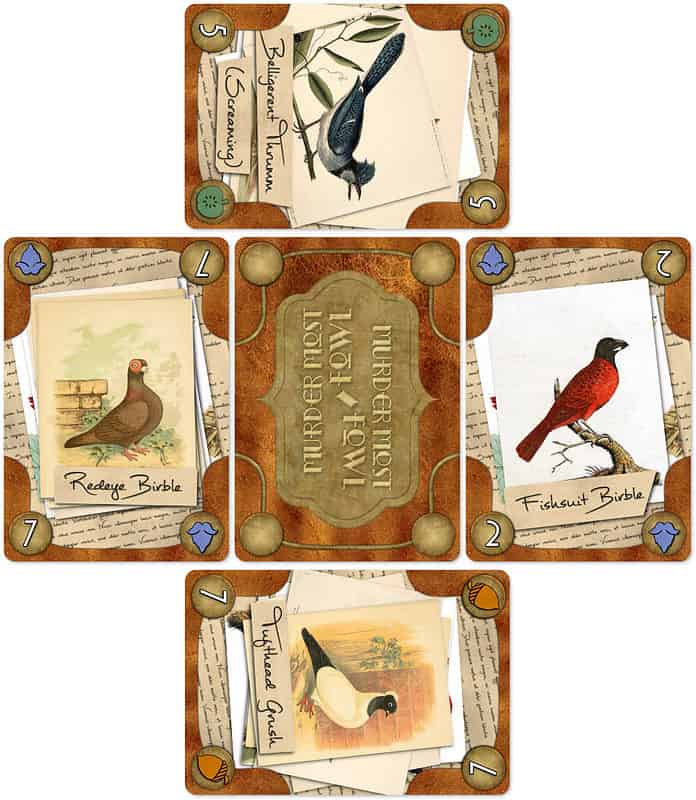
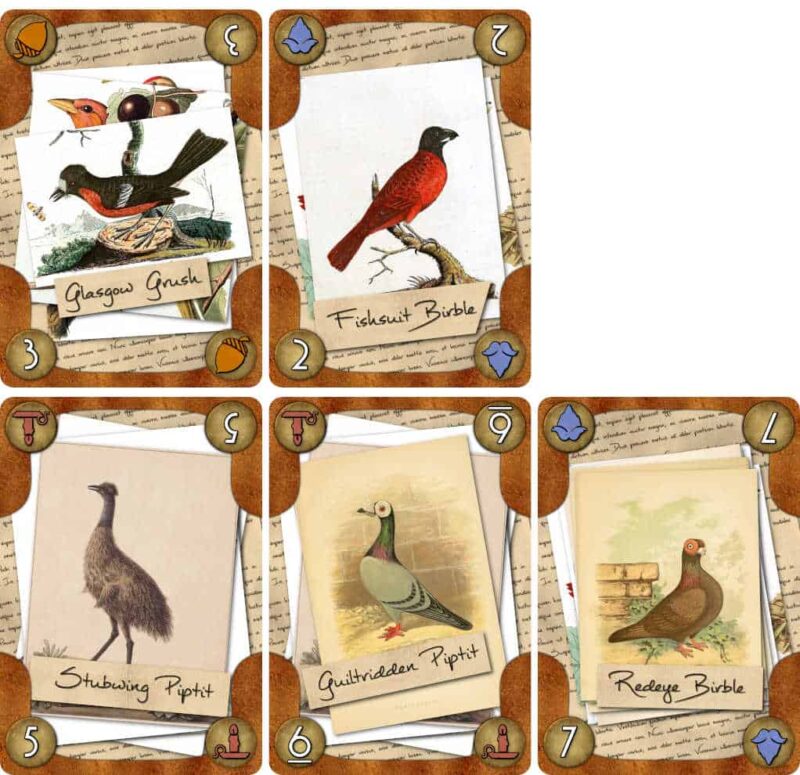
5 Comments
When a Wile is used to Swap a card, what happens to the bird card that’s been swapped out? Is it just discarded? and, if so, to where?
You put the wile in your path – then swap it with a bird from someone else’s. So you get to put your wile in their path and their bird in yours!
Also, when you draw from a discard pile, does it have to be the top card, or can it be any discarded card in any player’s pile?
Top cards of discard piles only!
Thank you!